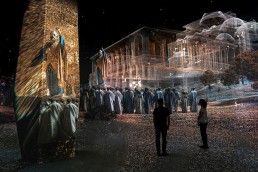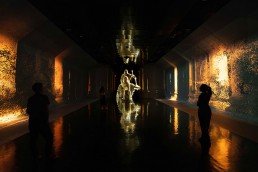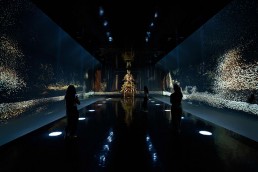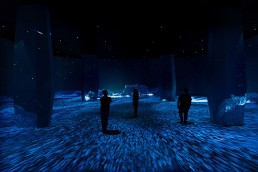This website uses cookies so that we can provide you with the best user experience possible. Cookie information is stored in your browser and performs functions such as recognising you when you return to our website and helping our team to understand which sections of the website you find most interesting and useful.
Ephesus Experience Museum
ProjectEphesus Experience MuseumLocationIzmir, TurkeyArchitectAtelier Brückner, Germany Lighting DesignerAtelier Brückner, Germany, Marshmallow Laser Feast, UK. InstallerAstel Proje Ve Entegrasyon A.S., Astel Profesyonel Goruntu Sistemleri A.S., TurkeyAcousticianL-Acoustics, Asimetrik (Turkey), Karakutu Electroacoustics (Turkey)Submitted byAstel Profesyonel Goruntu Sistemleri A.S., Turkey
Ephesus was an ancient port city whose well-preserved ruins are in modern-day Turkey. The city was once considered the most important Greek city and the most important trading center in the Mediterranean region. Throughout history, Ephesus survived multiple attacks and changed hands many times between conquerors. It was also a hotbed of early Christian evangelism and remains an important archaeological site and Christian pilgrimage destination.
Today the Ancient City of Ephesus which attracts nearly 3 million visitors worldwide annually, is listed in the UNESCO World Heritage List.
Ephesus Experience Museum is the first example where we combine scientific archeological knowledge with storytelling, people and emotions. Our goal was to create a museum that harmonizes with the original texture of Ephesus while using state-of-the-art technology to showcase this unique world heritage. To achieve this, we utilized cutting-edge storytelling technologies while also emphasizing the importance of preserving the historical heritage. Our first priority and challenge were ensuring that the museum built in Ephesus would not have any negative impact on the historical texture, which is a well-preserved archeological site. We’re somehow in the situation of creating spaces for the content, on the other hand we had a strong archeological site which we want to treat respectfully. So, we lay a strong emphasis on the environmental factors on sustainability, design and also implementation of the architecture. So, we want to be minimalistic and we want to be peaceful co-existing with the surroundings with a real minimal disruption of the archeological site. We placed the archeological volumes within an existing pine-tree forest and of course the existing flora was respected. Everything was pre-fabricated of course to avoid any invasions.
The surrounding area is densely covered with trees, allowing the proposed structure to blend in modestly without overshadowing the nearby archaeological finds and artifacts. Nearly 150 experts all over the world in different time zones and 10 archeologists took part in the whole project and it is completed within 26 months in August 2023.
We aim to combine reality and mythology in an engaging visual experience. There are cutting edge technologies such as virtual reality, 3D animations, artificial intelligence and all of these technical possibilities are used for immersive, personalized museum experience. The most difficult part was; the whole experience is not so much about technology, it’s more about access to communicate the content with emotions. We work both in the digital and analog space. We allow visitors to actively participate in storytelling and explore content via using all-state-of-the-art technological possibilities.
Museum visitors receive their pre-disinfected and personalized audio guides and headphones from museum staff. From the moment they enter the door of the museum, consisting of three separate halls, under the influence of the scenario that is created multi-lingual audio-guide which offers 17 different languages with video-synch. In addition to the audio from professional Sennheiser headphones, and the sound effects that circulate in all areas of the facility and continue synchronously with the flow of the immersive content, we bring together the images that make visitors feel like they’re wandering the streets of the historical city of Ephesus.
In our First Hall, all of the wall, floor and angled ceiling images were created using the “mapping” technique, which is defined in literature in the field of vision systems and combines very large and high resolution images from very short distances with more than 33 projection devices and special ultra short throw lenses. When it’s time to leave the First Hall, special curtains that keep the sound and effects we provide with subwoofers accompanying more than 30 speakers included in the automation are opened and visitos are directed to the main hall.
In our main hall,the only example of the mapping application, which was made using special lenses with a total of 90 Panasonic DLP projection devices of different light power and color quality, is the vibrations coming from the walls equipped with special speakers and sound systems of the L’Acoustics L-ISA system, which are heard separately from all parts of the hall in the background, with the earthquake effect of the content. We watch the visitors wander around a real street, in a real city, at the moments when we experience the real earthquake. We bring together the system, which gives the feeling of immersiveness, being in the ambient sounds and the tone that travels throughout the hall with the storytelling in the headphones simultaneously, in the perfect balance of the acoustics of the space with approximately 40 speakers and subwoofers.
In our Third Hall, we leave our visitors alone with a giant replica of Artemis, the goddess of the nature. Our Absen P1.6 LED Screens, effects coming from the sound system consisting of nearly 40 speakers, and a narrative that includes different light shows at every moment.
Lighting
The lighting and visuals are designed by worldwide brands Atelier Bruckner and Marshmallow Leaser Feast. Special lighting robots, which are one of the most important parts of this system, take their place in the automation, visitors can walk between the virtual columns with the activation of our fog/haze devices positioned with engineering calculations, and they’re fascinated by the silhouette formed on our hologauze screen, which gives a ghost effect that they didn’t notice before.
The spaces outside the exhibition halls, which should be dark due to the character of the digital exhibition, were handled as transparent as possible, thus aiming to make the building perceived lighter in the space. In practice, the high glass surfaces of these transparent masses become surfaces that reflect and multiply the surrounding landscape, contributing to the visual background of the masses in the natural landscape.
An interactive experience in which visitors meet with main historical charachters of ancient city of Ephesus which is produced professionally with 3D animations guided by archeologists and historians. A 360 degree immersive atmosphere is created so that visitors think they are wandering around the historical streets in the flow that follows the sound in their ears as they walk in the 250m2 area. It is created with 33 Panasonic DLP/3DLP projectors consisting of different light and color qualities produced with the high technology used in our first hall, combined with a special mapping technique that gives the feeling of being inside the place angularly.
In our First Hall, all of the wall, floor and angled ceiling images were created using the “mapping” technique, which is defined in literature in the field of vision systems and combines very large and high resolution images from very short distances with more than 33 projection devices and special ultra short throw lenses. When it’s time to leave the First Hall, special curtains that keep the sound and effects we provide with subwoofers accompanying more than 30 speakers included in the automation are opened and our guests are directed to the main hall.
When our visitors enter our main hall, they encounter a monolithic image on the floor and all the walls along the area with the pleasant smell of the environment, they pass through the 8-meter image-reflected columns that carry the hall, and before they know it, they’ll start walking on the streets of the ancient city, they’ll briefly pass through the 7-meter-high building, which has no other example in the world. When they realize that the colorful waves on the 750m2 perforated seamless screen, which has passed special acoustic tests and covers four walls with its multi-geometric structure, become a whole with the 650m2 floor, they’ll experience the feeling of being in and a part of the environment with excitement.
In our main hall, the only example of the mapping application, which was made using special lenses with a total of 90 Panasonic DLP projection devices of different light power and color quality, is the vibrations coming from the walls equipped with special speakers and sound systems of the L’Acoustics L-ISA system, which are heard separately from all parts of the hall in the background, with the earthquake effect of the content. We watch the visitors wander around a real street, in a real city, at the moments when we experience the real earthquake. We bring together the system, which gives the feeling of immersiveness, being in the ambient sounds and the tone that travels throughout the hall with the storytelling in the headphones simultaneously, in the perfect balance of the acoustics of the space with approximately 40 speakers and subwoofers.
In our Third Hall, we leave our visitors alone with a giant replica of Artemis, the goddess of the nature. Our Absen P1.6 LED Screens, effects coming from the sound system consisting of nearly 40 speakers, and a narrative that includes different light shows at every moment.
The structure of the Ephesus Experience Museum is located in an area that used as a military building in past years. The historical texture within the archaeological region was not disturbed during the construction process. Irregularly built Military Buildings were removed to make way for the museum. The design of the building incorporated the traces of the road used by the building, preserving the existing natural and archaeological texture. The surrounding area is densely covered with trees, allowing the proposed structure to blend in modestly without overshadowing the nearby archaeological finds and artifacts. In total 2340 m² of landscape area was designed for the facility designed as 2400 m² closed area.
A maximum of 50cm excavation was made for foundation placements in the existing settlement area. The entire building was constructed as steel construction on concrete single foundations in accordance with the project. The floor of the building is formed with aerated concrete blocks on steel construction.
The proposed building mass is handled as fragmented as possible, and the circulation between the masses is organized through open spaces as much as possible. The heights of the exhibition halls and support spaces also vary in order to support this fragmented organization. The reason for the fragmented design is that the existing tall and old trees in the area can be preserved in the massing and site plan design.
As the foundation system of the building, shallow and point reinforced concrete shoes / single foundations were designed, thus avoiding deep foundation excavation during the foundation production of the building.
These foundation shoes were prefabricated and transported to the site ready for use. Thus, any concrete pouring in the area was prevented.
The building was completed as planned with completely dry assembly fabrications. No concrete was poured in the area during any manufacturing phase and the natural texture of the land was not damaged. At the end of its lifetime, all building components can be disassembled and quickly removed from the site. In this sense, the principles of circular design were strictly adhered to during the implementation phase.
As a conclusion Ephesus Experience Museum was completed in August 2023 by maintaining the sensitivity observed from the first phase of the project during the implementation phase. As envisaged, the structure was completed as a visually unnoticeable/invisible structure in the natural landscape that does not compete with the original structural remains of the ancient city, does not prevent the existing image and iconic structural features of the area by adapting to the natural topography and landscape structure. As envisaged during the project phase, the installation was completed entirely with prefabricated assembly techniques and can be dismantled and removed from the site in the same way.
In addition to the projection devices that reflect the contents that give the feeling of being in a three-dimensional simulation with detailed visual effects, 16 light robots and fog/haze machines that turn the light reflected by these robots into a column impressively take their place in the story. When our special lighting robots, which are one of the most important parts of this system, take their place in the automation, they can walk between the virtual columns with the activation of our fog/haze devices positioned with engineering calculations, and they’re fascinated by the silhouette formed on our hologauze screen, which gives a ghost effect that they didn’t notice before.
Special sound effects designed for each room coming from the walls equipped with special speakers and sound systems of the L’Acoustics L-ISA system, which are heard separately from all parts of the hall in the background, with the earthquake effect of the content.
We allow visitors actively participate in the content via using all their senses, so a unique Ephesus fragrance is designed by professional perfumists.
Accessibility for the disabled has been emphasized both in the open space and within the building, and every part of the building has been completed with this sensitivity.
The open areas surrounding the museum building were designed to use the natural ground level as much as possible. In cases where the natural ground level could not be used and leveling was required, L-section precast concrete elements were used to partially fill the natural ground without excavation and foundation. Similar precast concrete modules were also used in the implementation of resting and seating areas in the open area.
In accordance with the landscaping project, the landscape project was completed in harmony with the existing texture. The hard floor was made with granite coating on steel construction and cube stone coatings on natural ground, and the remaining area was completed with pebbles and vegetation suitable for the ruins. Existing trees were preserved.
As cultural places, museums and ruins are inseparable parts of the creation process of cultural and historical identity. Museums, which are important places that protect and pass on knowledge about human civilizations, as well as bonds that link the past, present, and future, play a special role in promoting the exchanges and mutual learning among the world’s civilizations.
Many museums have realized the fusion of history and modernity through technology to make cultural relics collected in museums come alive. Ephesus Experience Museum has a unique touch in this sense. The development of digital methods at Ephesus has also enabled the creation of various animations at archaeological sites, offering new perspectives on historical artifacts and sites. By incorporating contemporary digital display and animation techniques, it is possible to bring the social life and urban texture of the Ancient City of Ephesus in different time periods to life, allowing visitors to better understand the city’s history.
We aim to combine reality and mythology in an engaging visual experience. There are cutting edge technologies such as virtual reality, 3D animations, artificial intelligence and all of these technical possibilities are used for immersive, personalized museum experience. The most difficult part was; the whole experience is not so much about technology, it’s more about access to communicate the content with emotions. We work both in the digital and analog space. We allow visitors to actively participate in storytelling and explore content via using all-state-of-the-art technological possibilities.
We offer an effective and unique experience where we can simultaneously host visitor groups of 200 people without interruption which lasts 20 minutes in total.
Every museum is a big school. Museums, which are important places that protect and pass on knowledge about human civilizations, as well as bonds that link the past, present, and future, play a special role in promoting the exchanges and mutual learning among the world’s civilizations. Ephesus Experience Museum is a very good example in that it attracts the attention of future generations while transferring the historical heritage to future generations. It has opened a new era in museology, in telling the unique cultural heritage and historical stories of many parts of the world to future generations.








